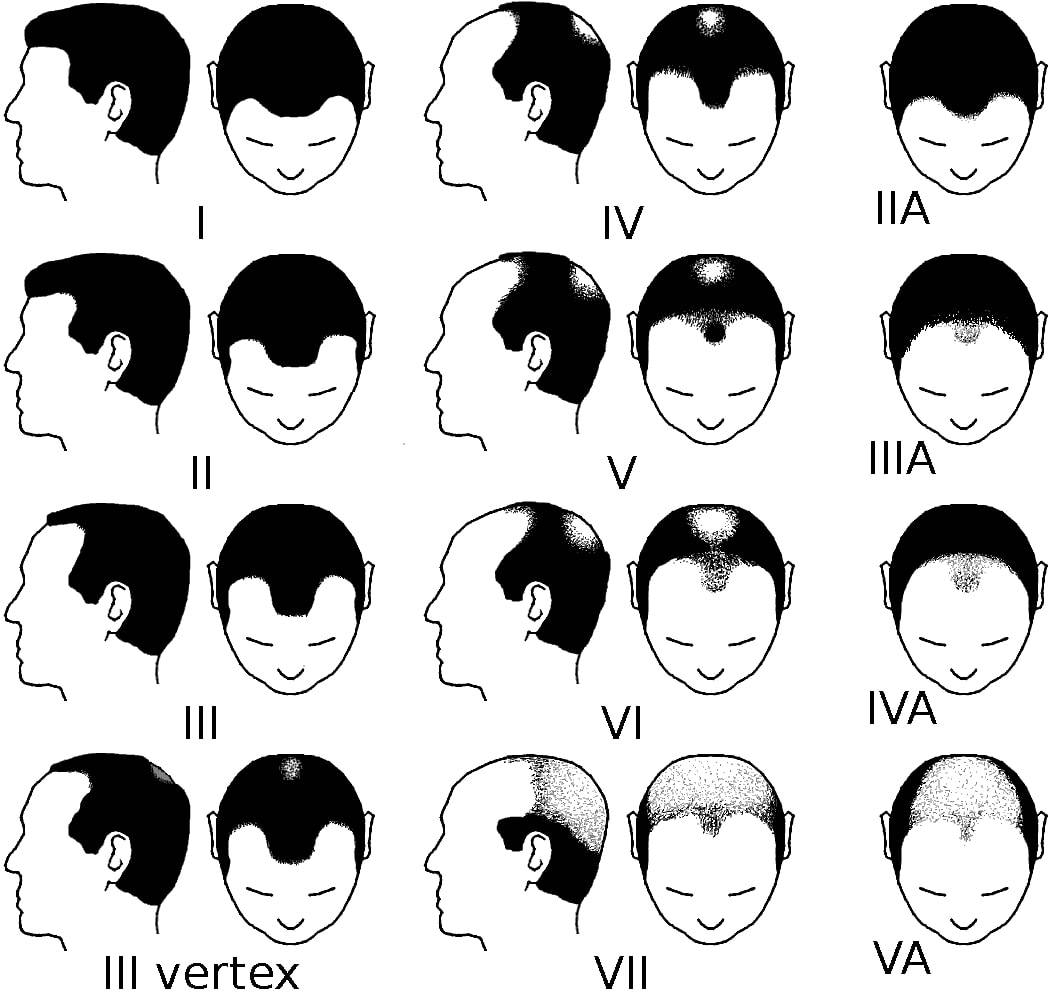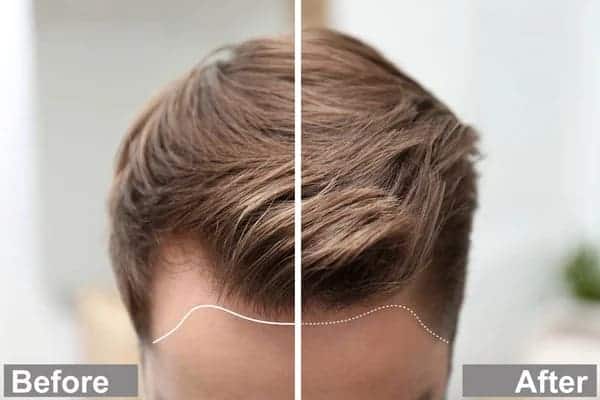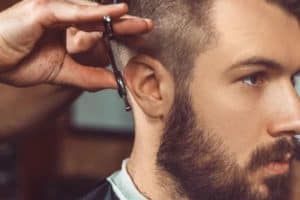As we get older, we mature with age. Whether we reach an emotional or psychological maturity in the way we act, or grow into our bodies, this is a process that we all go through. But did you know our hairlines mature as well? Hair loss is actually a key sign of this.
For most men, a juvenile hairline in adulthood is simply a wish. Whether your hair loss means your hairline is maturing, or something worse (like a receding hairline), there’s plenty of things you can do to work out what you may be suffering with. On this page, you will find everything you need to know about a mature hairline. Be sure to scroll down and find out information on: mature hairlines, receding hairlines, balding hairlines and so much more!
What is a Mature Hairline?
Over the course of your life, your body will change as it matures. As a man ages, his shoulders may broaden, his stomach may naturally carry more fat, and he may begin to lose muscle mass past the age of 40. This is completely normal. It is a simple a result of hormonal changes and lifestyle choices. Your hairline is no different. Like the rest of your body, your hairline will change and develop as you age, reaching maturity between the age of 25 and 30.
Every man has a hairline! It is the name we give to the hair on the edge of the frontal region on your head. From your temples to your forehead, this is all your hairline. Over the course of your life, this hairline may change shape, thickness, and colour. It’s natural and nothing to worry about.
The mature hairline develops after a man’s teenage years. A man’s hair will be at its thickest during his teenage years, and will also have the shortest distance between the hairline and eyebrows. Doctors and Hair Transplant surgeons call this a “juvenile hairline”. The juvenile hairline takes place in boys/men aged 10-16 years.
In many cases, a mature hairline will take the shape of a gentle “M” or “V” (the widow’s peak). So think of yourself as Chris Hemsworth, Tom Hardy, or Harry Styles!
From the ages of 17-30, men will naturally develop a mature hairline. After this, a hairline will not change drastically from this age, unless a person suffers with a condition called male pattern baldness (androgenetic alopecia).
How Does a Hairline Mature?
A person’s mature hairline is almost entirely dependent upon their hormonal balance and genetic factors. Aside from this, there is relatively little we can do about our hair, other than cut it and style it. However, this definitely won’t stop you going bald.
First, our hairline recedes naturally in accordance with our genetic makeup. You will be able to gauge a rough idea as to how your mature hairline will look if you observe your parents. If you look at this, you’ll be able to see how your hairline will probably look in the future, in terms of: hairline shape, thickness, and even colour.
Our hairline is also regulated by a hormone called dihydrotestosterone (DHT). This is produced by our body and is directly responsible for how our hairlines mature or recede. Whilst DHT is one of the hormones giving men their sex drive and lean muscle mass, it is also responsible for making our hair recede and mature.
DHT is able to bind with the hair follicles on your head, causing them to shed and not grow back. This is part of the natural life cycle of our hair follicles. For more information on this, check out our page on Telogen Effluvium.
Diagnosing Mature Hairlines
Maturing hairlines are actually quite easy to diagnose. But before we give you this information, it’s important to understand the Hamilton-Norwood scale.
The Norwood Scale is what doctors use to track and diagnose a person’s hairline recession. The scale is split into seven stages. Stage 1 refers to a juvenile hairline and Stage 7 is almost Total baldness.

A maturing hairline will generally look like Stage 2 on this scale, and should not recede any further than this stage. If you want to know more about the Hamilton-Norwood Scale, click the link above!
During this time, someone with a maturing hairline would likely experience some mild symptoms of:
- hair loss
- slight/gradual receding.
- defined hairline (you should still be able to see a definite shape)
Whilst a maturing hairline is a completely natural occurrence, if you’re worried ask a friend, partner, or loved one to keep an eye on your hairline. If they notice anything like drastic receding or thinning hair, tell them to inform you.
When Will a Hairline Mature?
Only 5% of caucasian men will carry their juvenile hairline into full adulthood. For the rest of us, our hairlines recede an inch or two. As such, many will experience some hair loss.
A man’s hairline will start to mature around the age of 17 to 20. Many men report this to be quite a discomforting time, with many thinking that losing hair is a sign of receding hairline. But this isn’t always the case.
During this time, your hairline will begin to recede slightly in the temple area and you may experience hair loss. Most men seem to recede about half an inch. Beginning with a juvenile hairline, you should recede into a hairline resembling something similar to Stage 2 on the Norwood Hamilton Scale.
Whilst maturing hairlines can begin between 17-20, it is not uncommon for the process to occur at any point up to the age of 30. This hair loss is just a sign of maturity. Your hair will reach a natural point from which you will not recede much further for the rest of your life.
A mature hairline generally takes the shape of an “m” or “v” (widow’s peak). That’s when your maturing hairline will begin to rest. You shouldn’t experiences significant recession after this.
If you seem to experience hair loss beyond the age of 30, or believe your hair pattern resembles stages 3 and beyond (on the Hamilton-Norwood scale), then this may be a sign of male pattern baldness.
If you’re worried about receding, have a look at your family history and consult some pictures. Use this article as a guide and ask yourself, do they have mature hairlines or receding hairlines?
How does a Mature Hairline Look?
Well, it’s difficult to say. Perhaps it is best to use an example. Take a look at Gentleman A. This man appears to be in his early-to-mid 50s. Given his age, he looks to have matured at least two decades ago.

In this particular instance, the mature hairline takes the form of a gentle “M” shape. The hairline recedes up into the temples but still appears full in the frontal area. This is one of the most common mature hairlines in men.
So how can we tell this gentleman’s hairline is mature and not receding? Whilst the difference between the two is discussed later in this article, here’s the short answer:
- this man looks to be beyond the typical age of maturation (17-30) and does not look to have receded particularly far.
- the distance between his eyebrows and frontal hairline is little more than an inch in distance.
- there doesn’t appear to be much thinning hair follicles in the front.
Maturing Hairline vs Receding Hairline: What’s the Difference?
Whilst they may seem similar on the surface, there is clear difference between a mature hairline and receding hairline.
A man may have a mature hairline if categorised he is categorised having a distance of around an inch between the frontal hairline and the eyebrow. Moreover, the hair at the front of his hairline will not typically show any signs of thinning. He should look luscious and thick at the front.
If a man shows no sign of thinning in the crown area (the top of the head), then he will have a mature hairline. Similarly, if hair loss occurs during the age of 17-30, then this is indicative of a mature hairline.
So, what is a receding hairline and what are the signs? Whilst a mature hairline could be viewed as a receding hairline, a hair transplant surgeon would look for the following signs to describe you as having a receding hairlines:
- a receding hairline would need to be categorised as having at least a stage 3, or 3V, on the Hamilton-Norwood Scale. This would be categorised as extensive receding (above an inch) up the temple area and, in some cases, beginning to thin in the “vertex”, or crown, area.
- a receding hairline occurs at a much faster pace than a mature hairline. Over the course of a couple of months, you will see great variance in your hairline. You are probably less likely to notice a maturing hairline.
Maturing Hairline vs Balding:
So, you’ve seen a receding hairline and mature hairline. But how is this different to a balding hairline? Well, balding is one of the most advanced form of male pattern baldness. This is what separates it from a mature hairline, and likens it to a receding hairline.
Balding is a process that occurs after someone suffers with a receding hairline. After receding up the temples, balding will begin slowly in the crown area, before it expands in size and the bald temple and crown meet.
If we use the Hamilton-Norwood Scale, then large balding occurs from Stages 6 and 7. However, balding may also be noticeable from Stage 3V. If someone has a mature hairline, they are unlikely to lose a noticeable amount of hair follicles on their crown.
Balding should be a huge giveaway that your hairline may not simply be maturing but is, in fact, receding. If you think you’re suffering with a receding hairline, or male pattern baldness, then you could consider having an fue hair transplant.
The “V” and “M” Shaped Hairlines
The V and M shape is the most common hairline shape in caucasian men. Both are relatively similar and differ only in the shape of the frontal hairline.
As has been stated earlier, an M shaped hairline is where the hair on the front and sides remains in place, but the hairline recedes up the temples, creating an m shape. Generally, this is quite a steep shape.
Although this is not always the case, the m-shape can be an indicator that you have a receding hairline. Whilst your receding will depend your genetic makeup and hormonal balance, it is not always a given that you will continue to bald.
If you have an m shaped hairline and are worrying about receding further, be on the lookout for hair loss on your comb, shower, or pillow in a morning. Also look for thinning on top. This will be a major giveaway that you have a receding hairline instead of mature hairline.
The “V” shape, sometimes called the “widow’s peak”, takes the form of a V. Whilst this is similar to an “M” shape, the “V” meets at a triangular mid-point and is generally less steep than an “M”.
The “U” and “O” Shaped Hairlines
If your hairline resembles a U or O shape, this is a clear indicator that you are suffering with male pattern baldness. The “O” refers to the total balding in the crown area. In some men, this may even turn shiny as your hair follicles shed and rest.
Should you continue to bald from here, your hairline will eventually look like a “U” shape. This is where the temple and crown balding meet, leaving only hair on your back and sides. If you wish to gain your hairline back, then this would certainly require hair restoration surgery.
How Can I spot Signs of Hair Loss?
If you think your hairline is beginning to recede more than what you think to be it’s mature state, there are plenty of things to do.
First, you could begin by measuring the distance between your hairline and eyebrow line over the course of six months to a year. If you believe this distance to be increasing, then this may be an indicator of male pattern baldness.
If you use a comb or brush, give it a clean every day or week. Doing this, you can monitor how much hair you’re losing over a given period of time. If the amount of hair on your comb or brush begins to increase, then this may be a sign of hair loss or male pattern baldness.
Another thing you can do is to use a mirror, or take pictures of your hair. If you can notice excessive hair shedding, balding, or receding, then this may be a sign fo hair loss.
Hopefully, this should mark some differences between mature and receding hairlines.
What Can I do to Prevent Hair Loss or Pattern Baldness?
There are plenty of things you can do if you think you are balding, or receding. One of the first actions you can take is to use dedicated hair loss shampoo. Using a hair loss shampoos will help to slow down the effects of male pattern baldness and keep your hair growth on tip top form.
Even if you have a mature hairline, it is always good to use a hair loss shampoo anyway. This will help to keep your cool mature hairline looking full and thick. Come on guys, it’s time to stop using whatever your partner buys!
Whether you have a receding or mature hairline, it’s always good to minimise the time you spend using elements that could cause damage to your hair or scalp. Minimising the amount of time you spent heating your hair (hair dryer), putting your hair in tight styles (for those with long hair), or putting harsh chemicals (like some styling waxes or gels) can prevent scalp irritation, inflammation, and traction hair loss.
If your male pattern hair loss is beginning to become noticeable, many men try chemical treatments such as minoxidil or finasteride. Whilst men with mature hairlines do not need any such treatments, these treatments are designed to keep your hair follicles growing and healthy.
If your male pattern baldness is becoming a real problem, then there may be no option other than a fully fledged hair transplant. At Harley Street Hair Transplant Clinics, you can book a free consultation with one of our GMC registered hair transplant surgeons today!








